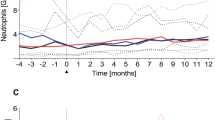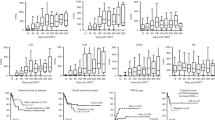Abstract
We investigated bone marrow (BM) and circulating (PB) hematopoietic progenitor cells in 37 normal donors and in 25 patients 1 to 8 years after successful allogeneic bone marrow transplant. At the time of testing, transplanted patients had normal blood counts and bone marrow cellularity. By flow cytometry, BM CD34+ cells were found to be three- to four-fold decreased in transplanted patients compared to normal donors, while the number of PB CD34+cells was the same as in normal donors. Using a methylcellulose colony assay, primary BM colony-forming cells (CFU-GM) were decreased 2.1-fold, whereas PB CFU-GM were only marginally decreased. In a long-term culture initiating cell (LTC-IC) assay, an eight-fold decrease of early progenitor cells was observed in the marrow of transplanted patients compared to normal donors, and a five-fold decrease was documented in peripheral blood. We found that the BM LTC-IC cell number correlated with concurrently determined BM CD34+ cells and committed progenitor cell number (measured as CFU-GM) and with PB LTC-IC number, but not with PB CFU-GM and CD34+ cells. We conclude that marrow and circulating early stem cell compartments, as measured by the LTC-IC assay, are greatly and permanently depressed following bone marrow transplant. The correlation between BM and PB LTC-IC indicates that the enumeration of circulating LTC-IC can be used as a measure of the stem cell compartment in the bone marrow after transplant. It seems that the deficiency of the most immature progenitor cells persists forever after successful bone marrow transplant; this means that a complete hematopoietic reconstitution can be sustained by a reduced stem cell pool.
This is a preview of subscription content, access via your institution
Access options
Subscribe to this journal
Receive 12 print issues and online access
$259.00 per year
only $21.58 per issue
Buy this article
- Purchase on Springer Link
- Instant access to full article PDF
Prices may be subject to local taxes which are calculated during checkout
Similar content being viewed by others
Author information
Authors and Affiliations
Rights and permissions
About this article
Cite this article
Selleri, C., Maciejewski, J., De Rosa, G. et al. Long-lasting decrease of marrow and circulating long-term culture initiating cells after allogeneic bone marrow transplant. Bone Marrow Transplant 23, 1029–1037 (1999). https://doi.org/10.1038/sj.bmt.1701759
Received:
Accepted:
Published:
Issue Date:
DOI: https://doi.org/10.1038/sj.bmt.1701759
Keywords
This article is cited by
-
Allogeneic transplantation of peripheral blood stem cell grafts results in a massive decrease of primitive hematopoietic progenitor frequencies in reconstituted bone marrows
Bone Marrow Transplantation (2020)
-
Eltrombopag for post-transplant cytopenias due to poor graft function
Bone Marrow Transplantation (2019)
-
Human multipotent hematopoietic progenitor cell expansion is neither supported in endothelial and endothelial/mesenchymal co-cultures nor in NSG mice
Scientific Reports (2019)
-
Multi-color immune-phenotyping of CD34 subsets reveals unexpected differences between various stem cell sources
Bone Marrow Transplantation (2016)
-
Beneficial treatment with risedronate in long-term survivors after allogeneic stem cell transplantation for hematological malignancies
Osteoporosis International (2003)



